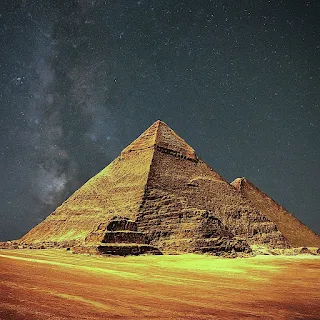The Great Pyramid of Giza: A Timeless Wonder of Ancient Egypt

|
| The Pyramids at Giza, Egypt: Monumental masterpieces narrating the extraordinary engineering skills of the ancient Egyptians. |
The Great Pyramid of Giza (also known as the Pyramid of Khufu or the Pyramid of Cheops) stands as an iconic symbol of ancient Egyptian civilization. As the oldest and only surviving monument of the original Seven Wonders of the Ancient World, it continues to inspire awe among historians, archaeologists, and millions of visitors every year.
In this article, we explore the history, construction techniques, architectural brilliance, and symbolism that make the Great Pyramid one of humanity’s greatest achievements.
Historical Background of the Great Pyramid of Giza
Constructed during Egypt's Fourth Dynasty (circa 2580–2560 BC), the Great Pyramid served as the grand tomb for Pharaoh Khufu (Cheops in Greek). Rising to an original height of 146.6 meters (481 feet), it was the tallest human-made structure for over 3,800 years.
Located on the Giza Plateau near modern-day Cairo, the pyramid reflects Khufu’s ambition to display divine authority and ensure a safe passage to the afterlife. Its alignment to the cardinal points and use of advanced mathematical concepts showcase the ancient Egyptians' expertise in astronomy, engineering, and geometry.
How Was the Great Pyramid Built? Ancient Construction Techniques
Building the Great Pyramid with limited technology remains a fascinating topic. Comprising around 2.3 million limestone and granite blocks (some weighing up to 80 tons), it demanded a labor force estimated at 20,000–30,000 workers.
Key construction theories include:
- Straight or Spiral Ramp System — To move stones higher as the pyramid rose.
- Counterweights and Levers — To assist in lifting heavy blocks.
- Water Transport — Stones floated via waterways closer to the site.
Regardless of the exact methods, the Great Pyramid’s creation stands as a monumental example of human ingenuity, precision, and perseverance.
Architectural Brilliance of the Great Pyramid
The architectural design of the Great Pyramid showcases astonishing precision:
- Base Area: 13 acres
- Side Length: Approximately 230 meters (755 feet) each
- Alignment: Almost perfect alignment with the cardinal points (north, south, east, west)
The pyramid’s internal layout includes three chambers: the King's Chamber (housing Khufu's granite sarcophagus), the Queen's Chamber, and the Subterranean Chamber. Above the King's Chamber are relieving chambers to distribute weight and prevent collapse.
The ingenious Grand Gallery, a steeply inclined corridor, exemplifies advanced engineering. Its corbelled walls effectively manage the structure’s immense stress — all without modern equipment!
Symbolism and Spiritual Significance
The pyramid’s shape symbolizes the sun's rays and the pharaoh’s connection to the sun god Ra. The careful astronomical alignments reflect the Egyptians’ deep spiritual and scientific understanding of the cosmos.
Functionally, the Great Pyramid was a gateway to the afterlife, designed to protect the king’s remains and possessions essential for his eternal journey. The pyramid complex included temples, causeways, and smaller pyramids dedicated to queens.
Legacy and Modern-Day Importance
Today, the Great Pyramid of Giza remains an enduring symbol of human achievement, resilience, and mystery. It attracts millions of tourists every year, making it one of the top historical attractions in the world.
Technological innovations like 3D modeling and ground-penetrating radar continue to uncover hidden secrets within the pyramid — including the possibility of undiscovered chambers!
As both a historical marvel and a symbol of human aspiration, the Great Pyramid of Giza stands timeless, bridging the ancient and modern worlds.
Quick Facts About the Great Pyramid of Giza
- Location: Giza Plateau, Egypt
- Built For: Pharaoh Khufu
- Height (original): 146.6 meters (481 feet)
- Estimated Stones Used: 2.3 million
- Construction Period: Around 20 years
- Alignment: Almost perfect with true North
- Significance: Only surviving wonder of the Seven Wonders of the Ancient World
Did You Know? Despite centuries of erosion and human interference, the Great Pyramid remains largely intact, a tribute to ancient Egypt's enduring legacy.
If you found this article insightful, be sure to check out our other posts about the Seven Wonders of the World and ancient civilizations!
